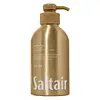What's inside
What's inside
 Key Ingredients
Key Ingredients

 Benefits
Benefits

 Concerns
Concerns

 Ingredients Side-by-side
Ingredients Side-by-side

Water
Skin ConditioningPropanediol
SolventIsopentyldiol
HumectantChondrus Crispus Extract
Skin ConditioningSodium Hyaluronate
HumectantPolyacrylate Crosspolymer-6
Emulsion StabilisingAmorphophallus Konjac Root Extract
HumectantTremella Fuciformis Polysaccharide
Emulsion StabilisingChlorella Ferment
Skin ConditioningHibiscus Rosa-Sinensis Flower Extract
HumectantArginine
MaskingCaprylyl Glycol
Emollient1,2-Hexanediol
Skin ConditioningMagnesium Chloride
Phenoxyethanol
PreservativeHydroxyacetophenone
AntioxidantXanthan Gum
EmulsifyingCalcium Chloride
AstringentSodium Chloride
MaskingPotassium Chloride
Citric Acid
BufferingWater, Propanediol, Isopentyldiol, Chondrus Crispus Extract, Sodium Hyaluronate, Polyacrylate Crosspolymer-6, Amorphophallus Konjac Root Extract, Tremella Fuciformis Polysaccharide, Chlorella Ferment, Hibiscus Rosa-Sinensis Flower Extract, Arginine, Caprylyl Glycol, 1,2-Hexanediol, Magnesium Chloride, Phenoxyethanol, Hydroxyacetophenone, Xanthan Gum, Calcium Chloride, Sodium Chloride, Potassium Chloride, Citric Acid
Water
Skin ConditioningGlycerin
HumectantCocamidopropyl Betaine
CleansingSodium C14-16 Olefin Sulfonate
CleansingAcrylates Copolymer
Parfum
MaskingAleurites Moluccanus Seed Oil
Skin ConditioningCrambe Abyssinica Seed Oil Phytosterol Esters
EmulsifyingArgania Spinosa Kernel Oil
EmollientCocos Nucifera Oil
MaskingPassiflora Edulis Seed Oil
EmollientMauritia Flexuosa Fruit Oil
Skin ConditioningTocopherol
AntioxidantSodium Cocoyl Isethionate
CleansingAminomethyl Propanol
BufferingMica
Cosmetic ColorantTitanium Dioxide
Cosmetic ColorantIron Oxides
Tin Oxide
AbrasivePhenoxyethanol
PreservativePEG-150 Distearate
EmulsifyingSodium Benzoate
MaskingCitric Acid
BufferingTetrasodium Glutamate Diacetate
Sodium Hydroxide
BufferingBenzyl Salicylate
PerfumingWater, Glycerin, Cocamidopropyl Betaine, Sodium C14-16 Olefin Sulfonate, Acrylates Copolymer, Parfum, Aleurites Moluccanus Seed Oil, Crambe Abyssinica Seed Oil Phytosterol Esters, Argania Spinosa Kernel Oil, Cocos Nucifera Oil, Passiflora Edulis Seed Oil, Mauritia Flexuosa Fruit Oil, Tocopherol, Sodium Cocoyl Isethionate, Aminomethyl Propanol, Mica, Titanium Dioxide, Iron Oxides, Tin Oxide, Phenoxyethanol, PEG-150 Distearate, Sodium Benzoate, Citric Acid, Tetrasodium Glutamate Diacetate, Sodium Hydroxide, Benzyl Salicylate
Alternatives
Ingredients Explained
These ingredients are found in both products.
Ingredients higher up in an ingredient list are typically present in a larger amount.
Citric Acid is an alpha hydroxy acid (AHA) naturally found in citrus fruits like oranges, lemons, and limes.
Like other AHAs, citric acid can exfoliate skin by breaking down the bonds that hold dead skin cells together. This helps reveal smoother and brighter skin underneath.
However, this exfoliating effect only happens at high concentrations (20%) which can be hard to find in cosmetic products.
Due to this, citric acid is usually included in small amounts as a pH adjuster. This helps keep products slightly more acidic and compatible with skin's natural pH.
In skincare formulas, citric acid can:
While it can provide some skin benefits, research shows lactic acid and glycolic acid are generally more effective and less irritating exfoliants.
Most citric acid used in skincare today is made by fermenting sugars (usually from molasses). This synthetic version is identical to the natural citrus form but easier to stabilize and use in formulations.
Read more about some other popular AHA's here:
Learn more about Citric AcidPhenoxyethanol is a preservative that has germicide, antimicrobial, and aromatic properties. Studies show that phenoxyethanol can prevent microbial growth. By itself, it has a scent that is similar to that of a rose.
It's often used in formulations along with Caprylyl Glycol to preserve the shelf life of products.
Water. It's the most common cosmetic ingredient of all. You'll usually see it at the top of ingredient lists, meaning that it makes up the largest part of the product.
So why is it so popular? Water most often acts as a solvent - this means that it helps dissolve other ingredients into the formulation.
You'll also recognize water as that liquid we all need to stay alive. If you see this, drink a glass of water. Stay hydrated!
Learn more about Water